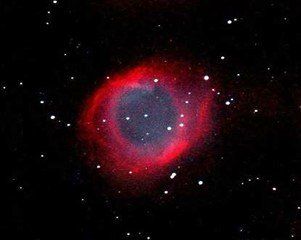DSO of the Month :
Helix Nebula
AKA: Caldwell 63; NGC 7293
Position: 22hr 29m 39s, −20° 50′ 14″
Due south at 23.52 (BST) on 15 September 2022
Helix Nebula
Image by HAS member Martin Gill (used with permission)
Once again we find ourselves back in the lower reaches of the sky. Even when the Helix Nebula is at the meridian it is only 17 degrees above the horizon. In theory its magnitude is a bright 7.6 but its low altitude will make it closer to 8.6 (about the same as M57) and as it is about the size of the full moon, its light is spread over a wide area. In short it is not easy to see visually although it is a splendid object for imagers. Perhaps for this reason, it escaped the attention of Charles Messier and William Herschel. It was discovered around 1824 by the German astronomer Karl Ludwig Harding who had previously discovered the asteroid (and dwarf planet) Juno in 1804. It is a planetary nebula which has a similar appearance to the better-known Ring Nebula (M57). It is a flattened spheroid which we observe from an angle of about 30 degrees from its equatorial plane. The nebula is about 655 light years away so it is the closest planetary nebulae to us and it is 2.5 light years wide. Like all planetary nebulae it is young and is reckoned to be 11,000 years old. The Helix nebula is located in a rather sparsely populated area in the southern part of Aquarius. It is roughly half-way between the bright but low star Fomalhaut and the rather dim star i Aquarii (mag. 4.3). The name Helix Nebula seems to have originated in the 1940s but like many such names did not really take off until the 1970s. It is also recently called the Eye of God, probably because of a famous false colour image taken by the Spitzer Space Telescope.

Helix Nebula taken in the infrared using false colours by the
Spitzer Space Telescope in 2007 NASA/JPL-Caltech/Univ. of Arizona
ARCHIVE
Triangulum Galaxy
Messier 41 NGC2287
Messier 104
Messier 27
Caldwell 13
Caldwell 25
PGC 41121; HIP 60936
The Blinking Nebula
Messier 31
Messier 46
Messier 51
Messier 11
